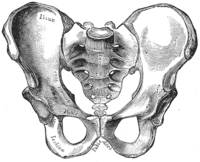
Photo from wikipedia
Background: The Valsalva maneuver is normally accompanied by relaxation of the levator ani muscle, which stretches around the presenting part, but in some women the maneuver is accompanied by levator… Click to show full abstract
Background: The Valsalva maneuver is normally accompanied by relaxation of the levator ani muscle, which stretches around the presenting part, but in some women the maneuver is accompanied by levator ani muscle contraction, which is referred to as levator ani muscle coactivation. The effect of such coactivation on labor outcome in women undergoing induction of labor has not been previously assessed. Objective: The aim of the study was to assess the effect of levator ani muscle coactivation on labor outcome, in particular on the duration of the second and active second stage of labor, in nulliparous women undergoing induction of labor. Study Design: Transperineal ultrasound was used to measure the anteroposterior diameter of the levator hiatus, both at rest and at maximum Valsalva maneuver, in a group of nulliparous women undergoing induction of labor in 2 tertiary‐level university hospitals. The correlation between anteroposterior diameter of the levator hiatus values and levator ani muscle coactivation with the mode of delivery and various labor durations was assessed. Results: In total, 138 women were included in the analysis. Larger anteroposterior diameter of the levator hiatus at Valsalva was associated with a shorter second stage (r = ‐0.230, P = .021) and active second stage (r = ‐0.338, P = .001) of labor. Women with levator ani muscle coactivation had a significantly longer active second stage duration (60 ± 56 vs 28 ± 16 minutes, P < .001). Cox regression analysis, adjusted for maternal age and epidural analgesia, demonstrated an independent significant correlation between levator ani muscle coactivation and a longer active second stage of labor (hazard ratio, 2.085; 95% confidence interval, 1.158–3.752; P = .014). There was no significant difference between women who underwent operative delivery (n = 46) when compared with the spontaneous vaginal delivery group (n = 92) as regards anteroposterior diameter of the levator hiatus at rest and at Valsalva maneuver, nor in the prevalence of levator ani muscle coactivation (10/46 vs 15/92; P = .49). Conclusion: Levator ani coactivation is associated with a longer active second stage of labor.
Journal Title: American Journal of Obstetrics and Gynecology
Year Published: 2019
Link to full text (if available)
Share on Social Media: Sign Up to like & get
recommendations!